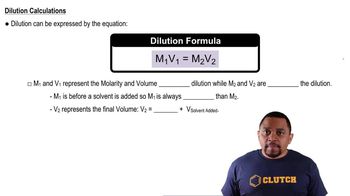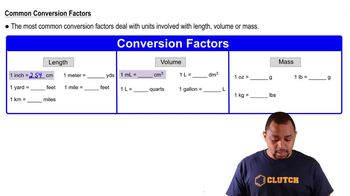Here are the essential concepts you must grasp in order to answer the question correctly.
Molarity
Molarity (M) is a measure of concentration defined as the number of moles of solute per liter of solution. It is expressed in moles per liter (mol/L) and is crucial for understanding how much solute is present in a given volume of solution. Molarity is commonly used in chemistry to prepare solutions and perform stoichiometric calculations.
Recommended video:
Dilution
Dilution is the process of reducing the concentration of a solute in a solution, typically by adding more solvent. The dilution equation, M1V1 = M2V2, relates the initial and final molarities (M1 and M2) and volumes (V1 and V2) of the solution. This concept is essential for calculating the new concentration after a solution has been diluted.
Recommended video:
Volume Conversion
Volume conversion is the process of changing the volume of a solution from one unit to another, such as milliliters (mL) to liters (L). Since molarity is expressed in terms of liters, it is important to convert volumes appropriately when performing calculations. Understanding how to convert between these units is vital for accurate concentration calculations.
Recommended video:
Common Conversion Factors

 Verified step by step guidance
Verified step by step guidance


